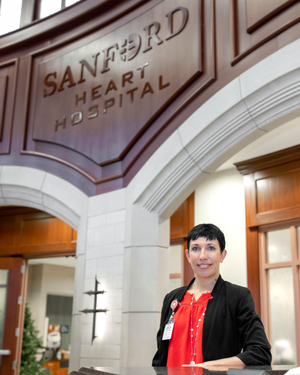The Sanford Heart Hospital Celebrates 10 Years
This year, Sanford Health celebrates the 10-year anniversary of the opening of the Sanford Heart Hospital in Sioux Falls, South Dakota.
A beacon for better heart care
For nearly 50 years, patients have turned to the heart program at Sanford Health. The health system’s long-standing history of offering advanced, personalized heart care was further advanced when the Sanford Heart Hospital opened in 2012.
And a decade later, that momentum only continues to grow. Today, the Sanford Heart Hospital leads the way in quality, innovative procedures and care centered around patients and their families.
“When we first opened in 2012, that’s when we started on our journey of how a building can improve the care experience for patients and staff,” said Bridget O’Brien-Johnson, MSN, the executive director of the Sanford Heart Hospital.
Attached directly to the Sanford USD Medical Center, the Sanford Heart Hospital ensures patients in and around South Dakota have access to all heart services under one roof – and close to home. Patients also have the benefit of being connected to a full-service hospital if another specialist is needed.
Years in the making
“Before the Sanford Heart Hospital, we had services in several different spots,” said O’Brien-Johnson. “We weren’t structured to best focus on the patient as a person and their family, which is an important aspect of the healing process.”
She continued, “The Sanford Heart Hospital changed that. Over the last 10 years, that’s been our focus: to ensure patients and their loved ones fully understand the care they need and can receive it in one location to the best of our ability. Even if they can’t get to Sioux Falls for care, through our outreach services, our specialists come to them in their own community.”
When planning the heart hospital, the project team worked with physicians, researchers, nurses, staff and patients to determine – from its outer walls to its entryways and hallways to the patient rooms – a design that worked for everyone.
O’Brien-Johnson explained, “Our patients and guests were our priority, so we went in asking: What does the experience look like for patients and families? We know it’s hard. It can be scary. How can we make that experience as smooth as possible? First, we needed everything in one building. Then, we looked at the building aesthetic.”
Sanford Health has always embraced the philosophy that the greatest capacity for healing occurs when stress and anxiety are lessened. And a welcoming, healing environment is a critical part of quality care.
The result was a building that features the signature Sanford Health collegiate gothic design and a setup that worked for providers and staff in preventive, critical and emergency care settings. Every aspect, including recessed lighting, music, scents and custom artwork, was considered in detail.
Sanford Heart partnered with local artists to produce commissioned artwork. Each floor still displays artwork that highlights nearby communities.
A seamless design
Beyond visuals, the functionality of the building for testing, procedural spaces and patient rooms was top of mind.
“We made a mockup of an inpatient room on top of the Sanford Surgical Towers. Staff had at least a year to go in there and tell us what worked, what didn’t work, what needed to move and what was missing,” O’Brien-Johnson explained. “Those inpatient rooms are so functional that, to this day, we haven’t had to make any modifications.”
Patient rooms use an acuity-adaptable care delivery model. Acuity-adaptable care is an emergency care model where the patient remains in the same room from the moment they arrive to when they are discharged, and services come to them.
“The rooms are also set up in three zones. There is a staff zone near the door that has all of their equipment, a zone for the patient bed and a family zone farthest from the door,” said O’Brien-Johnson. “This allows staff to provide care without having to cross over into the family area.”
A heart for patients
“The physicians who I have the opportunity to work with are incredibly motivated to learn and provide our community with the latest and greatest,” explained O’Brien-Johnson. “It seems like every year or so we’re celebrating a new technology, and it’s so exciting.”
Within months of opening the doors, the team at the Sanford Heart Hospital started the structural heart program, significantly expanding the heart care options available at Sanford Health. In September 2012, the Sanford Heart Hospital began performing transcatheter aortic valve replacements, or TAVR procedures, and other highly advanced treatments soon followed.
“Every time we have reached 250, 500 – or now we are at about 630 – TAVR procedures, it is a milestone. That procedure takes many different specialists and staff,” said O’Brien-Johnson.
Through TAVR and similar minimally invasive procedures, Sanford’s fellowship-trained team treats patients without open heart surgery, leading to fewer risks, less pain and a faster recovery.
The Sanford Heart Hospital has more than 750 of the most experienced heart experts in cardiology, electrophysiology, cardiovascular surgery, interventional cardiology, nuclear medicine, thoracic surgery, vascular care, rehabilitation and other specialties.
Most recently, the Sanford Heart Hospital received the American Heart Association’s Gold Get With The Guidelines - Heart Failure Quality Achievement Award in 2021. This recognition shows the Sanford Heart Hospital’s commitment to providing quality care for heart failure patients while they’re in the hospital or at home.
Looking to the future
Though ten years have passed, this is only the beginning for the Sanford Heart Hospital.
“My vision is to continue bringing innovative care models and talented physicians and staff to our community. Hopefully, we can keep the program growing and advancing into new areas of heart care that we aren’t offering our patients yet.”



